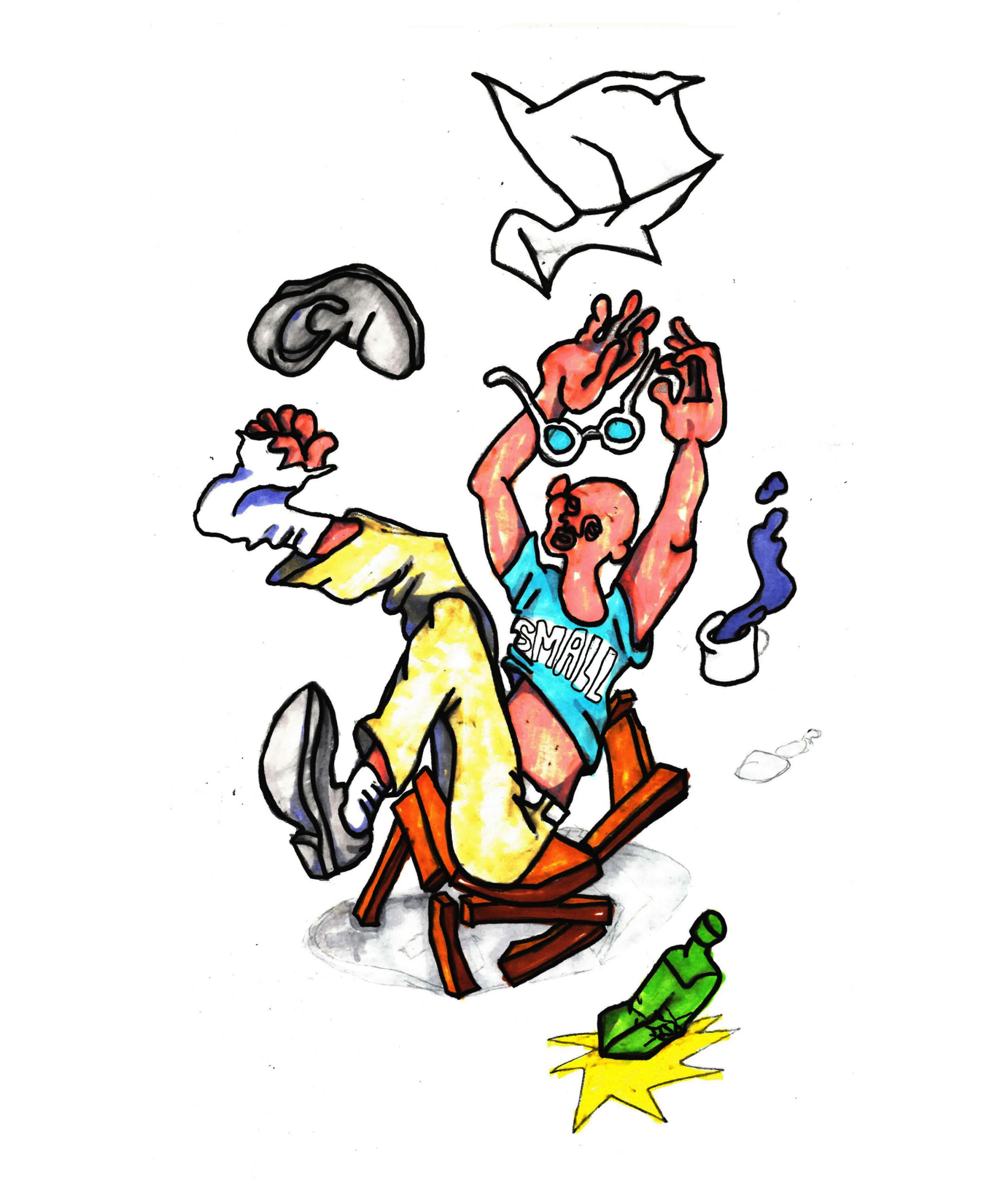How a Tall Man Sat on a Small Chair

art by Gerard Pefung
These facts alone can be established: that the chair, of slight physique, was sat upon and mortally wounded. Its guardian, a onetime carpenter, a man with a kinship to wood, issued the death certificate. “This chair cannot be repaired,” he said to no one in particular in his dusky baritone. In the nearby forest, the four-toed salamanders notorious for their eavesdropping shed their tails upon hearing the news.
The chair was qualified by virtue of its size and fitness to hold an elfin woman in a Chanel suit or a scrupulously groomed Bichon Frise. “Good things come in small packages,” the chair’s parents, a bar stool and a recliner, had reassured their offspring when they perceived that the chair would never grow to accommodate the Pope or Elton John or have legs like a chorus girl. Yet it had had a good upbringing and was raised to be polite. The small chair’s parents had taught it not to discriminate, emphasizing how a chair by its very nature is obliging. Thus can a chair flourish if both seat and sitter recognize their own commissions and shortcomings, as well as conscientiously performing their daily ablutions.
The tall man had always liked to imagine himself as smaller, perhaps because his father had continually told him he was “a waste of space.” Unhappily for the tall man, he already in boyhood was as conspicuous as a bookmark, his head invariably protruding above the top of the page. Once fully grown, this altitudinous specimen reared in the flatlands moved to an area of worn-down ancient mountains where he finally was surpassed in height. Still, he aspired to the status of one who didn’t stand out while at the same time talking vociferously, kicking ermines in his path, and habitually consuming more than his fair share of poutine. His wife routinely bought him T-shirts one size too small to placate his will to shrink.
How precisely the tall man crossed paths with the small chair is down to rumor. Nevertheless, the scuttlebutt among furniture is that the tall man, having been demoted at work, took a leave of absence to an off-grid destination, where he apprenticed in petit point and, on a battery-powered TV, compulsively watched reruns of Antiques Roadshow. In this unnamed locale, the tall man, imagining himself to be as diaphanous as an angel’s wing mushroom or a chiffon window treatment, concluded that the delicate chair would bear his weight. And in the event the chair broke, the fault would lie not with him but with the item of furniture.
A man, when all’s said and done, possesses entitlements, whereas a movable article is merely endowed with responsibilities. The tall man therefore did not conceive of how the act of sitting implied a partnership between him and the chair—a transaction not dissimilar to the give and take between fungus and alga. But no, from his vantage point, there was just one stakeholder: pronouns he/him. The tall man wished only to settle himself on the chair, after which he planned to parse a Gin and Tonic.
And so, it happened that on a summer’s day ornamented by the congregational song of cicadas, modified only by the repetitive downslur of a lone red-eyed vireo, the tall man loomed over the small chair. Perceiving a load that might be more than it could bear, the chair sighed, which, for a chair, entails a gentle slackening of its wooden slats.
Even an unassuming lapel button might have observed how so great was the distance between the upright man and the low-lying chair that a safe touchdown would have required the precision and savoir faire of a cake decorator or a trapeze artist. But the tall man, prone to impatience, could boast none of these aptitudes. He crash-landed. The chair’s slats gasped, then snapped, one of its forelegs convulsed, and it toppled onto its side. In human terms, the chair had suffered multiple life-threatening fractures, resulting, not unpredictably, in the loss of its life.
The tall man, however, exhibited no regard for the small chair. He himself had sustained an injury to his hallux—in lay terms, his big toe—and, more gravely still, to his pride. Words shaped like waterspouts and ground frost were expelled from the tall man’s mouth. “I want deference,” he cried. “Oops! I mean I want recompense!”
Recompense? the chair’s family and friends might have asked. Alas, the chair’s next of kin were never informed of its death. It had left instructions that its body parts could be donated to science. In the absence of avid researchers, the chair decreed that its wood could be recycled or sent to restore other chairs with missing elements. Above all, the chair didn’t wish to be cremated. This was stated explicitly in its will, for the chair did not die intestate. Chairs, like human beings, anticipate that their life will end.
The tall man’s vindictive abuse of the chair continued after its death, but his words were carried away by the wind as far as the Arctic, where a musk ox experiencing a shortage of lichen swallowed them whole, discovering them to have a bitter taste and to be without nutrients. One could say poetic justice, except that chairs have no appetite for poetry and are known to be averse to fiction.


